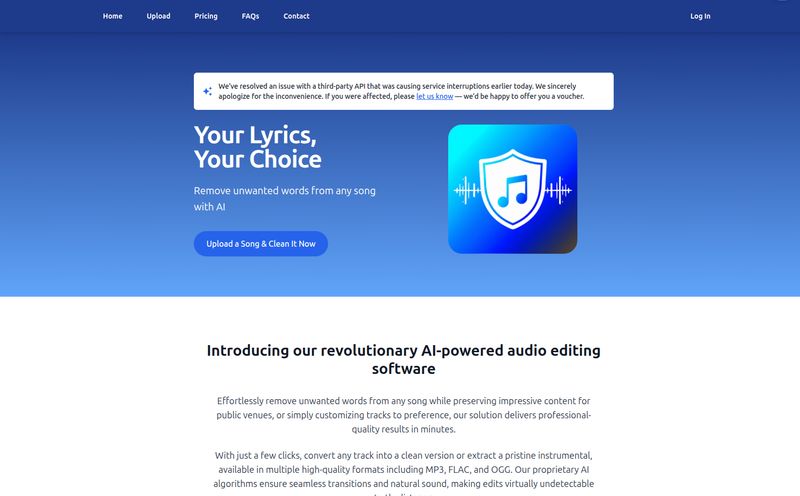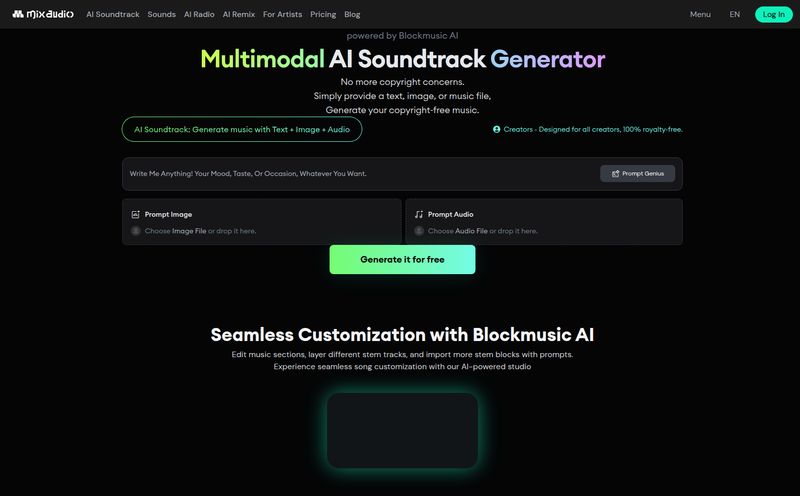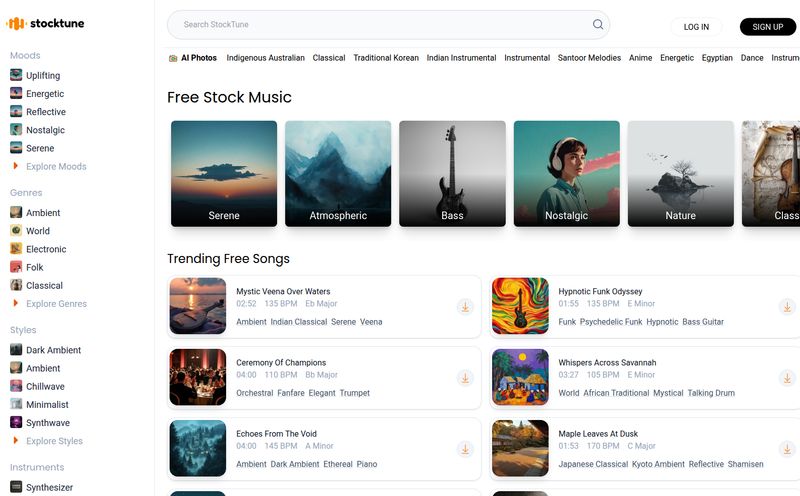You know that feeling? You’re deep into a mobile game, maybe on your commute, or you’re using a focus app to get some work done. The experience is great, but then you notice it. The same 90-second musical loop has been playing. For an hour. That heroic theme was cool the first ten times, but now it’s just part of the background hum, as noticeable and welcome as a leaky faucet.
It’s a tiny friction point, but it's one we've all just… accepted. In a world of dynamic, personalized digital experiences, audio often feels stubbornly static. It’s like watching a blockbuster movie where the soundtrack is just one song on repeat. Weird, right?
For years, I've been watching the generative AI space, especially in creative fields. We've seen AI art, AI writing, and now the audio world is really starting to cook. I recently stumbled across a platform that’s taking a fascinating approach to this problem: WarpSound. It’s not just another AI music generator that spits out a finished MP3. It’s something different. Something alive.
So, What Exactly is WarpSound?
Let's get the jargon out of the way. WarpSound is a generative AI music API. Okay, let's translate that from nerd to English. An API (Application Programming Interface) is basically a toolkit that lets developers plug one piece of software into another. In this case, WarpSound gives developers, game designers, and app creators a way to plug a smart, AI-powered composer directly into their projects.
Instead of just creating a song, WarpSound’s AI generates original music that can change and adapt in real-time based on what the user is doing. It’s less like a record player and more like a living, breathing session musician who’s watching your every move. Pretty cool stuff.

Visit WarpSound
The company claims the output is “studio-grade,” which is a bold claim in a world full of muddy, robotic-sounding AI tunes. But the whole idea is to move beyond the static, lifeless loops that populate so many of our digital interactions.
The Real Magic Is Music That Listens Back
This is the core of it, the thing that made me lean in. The real-time adaptation. Imagine playing an open-world game. You're walking through a peaceful forest, and the music is serene, maybe some gentle strings and a wood flute. But then, you spot an enemy. The music doesn't just switch tracks; it evolves. A sense of tension builds with a low, pulsing synth. As you draw your weapon, percussion kicks in. The fight begins, and the track is now a full-blown, high-energy battle theme. When you win, it resolves into a triumphant fanfare before settling back into a calmer exploration melody. That's the dream.
How This Sorcery Works
Without diving headfirst into a computer science lecture, the WarpSound AI is trained on musical theory, structure, and a massive library of sounds. The API listens for data inputs—things like user actions (running, jumping, standing still), in-app events (a timer starting, a goal being met), or even external data (like the weather or time of day). It then uses these inputs as cues to guide the musical composition. The AI isn't just crossfading between pre-made tracks; it's constructing the music, note by note, layer by layer, to fit the exact moment.
Who Should Be Plugging Into the WarpSound API?
Right off the bat, this isn't a tool for your average content creator looking for a quick background track for their YouTube video. There's no simple web interface where you type “upbeat corporate synth-pop” and get a download link. The fact that it's an API tells you everything you need to know about the intended audience.
This is for the builders. The innovators. The people creating experiences from the ground up.
- Game Developers: This is the most obvious one. From indie devs to larger studios, integrating truly adaptive audio could be a massive differentiator in a crowded market.
- App Creators: Think of fitness apps where the music intensity matches your heart rate, or meditation apps where the soundscape subtly shifts with your breathing patterns.
- Interactive Experiences: This could be used in museum exhibits, virtual reality worlds, or any digital installation where user interaction is a component.
- Live Streaming: Imagine a streamer's background music changing based on chat activity, donations, or in-game events. The possibilities are genuinely exciting.
The High Notes and the Flat Notes
No tool is perfect, and from my perspective as an SEO and tech enthusiast, WarpSound has some clear strengths and a few hurdles.
The biggest advantage is obviously the dynamic music generation. It’s the whole sales pitch, and it’s a powerful one. Creating something that feels unique to each user's session is a huge leap forward in immersion. Paired with the promise of original, studio-grade quality, it's a compelling package. The flexibility of an API means it can be integrated in countless creative ways, limited only by a developer's imagination.
However, that brings us to the main challenge: it requires real technical expertise. You can't just 'use' WarpSound; you have to implement it. You'll need a developer, or be one yourself, who is comfortable working with APIs. This immediately narrows the field of potential users. Another slight frustration is the limited public information on deep customization. While the API is flexible, the website doesn't offer a ton of specifics on just how granular you can get with genres, instruments, and moods. You probably have to get in touch to find that out.
So, How Much Does This Cost?
Ah, the million-dollar question. Or maybe the ten-thousand-dollar question? It's impossible to say. Like many specialized, business-to-business API services, WarpSound doesn't list its pricing publicly. There's no 'Basic, Pro, Enterprise' table to look at.
This usually means one thing: custom, quote-based pricing. The cost will likely depend on the scale of your project, the number of API calls you expect to make, and the level of support you need. While it’s a bit of a bummer for those of us who just want to peek at the price tag, it makes sense for a tool this specialized. It's not a SaaS subscription; it's an infrastructure component. My gut tells me this is aimed at well-funded projects and established companies rather than solo weekend coders. But hey, I could be wrong.
Is This the End of Stock Music?
Some might argue that AI tools like this threaten human composers. And you know, I get that. But I don't see it as a replacement. Is WarpSound going to be hired to score the next Star Wars film? Probaly not. The emotional depth and narrative storytelling of a masterful human composer is a different art form.
But for the millions of hours of background music needed for apps, games, and digital spaces? A tool like this isn't just an alternative; it's an upgrade. It’s a move away from generic, repetitive stock audio and toward something more personal and reactive. It’s not about replacing the composer; it’s about getting rid of the tired old record player and bringing in a dynamic live performer. And in my book, that’s a huge win for everyone.
Frequently Asked Questions
- What is WarpSound in simple terms?
- It's an AI tool for developers that creates music on the fly. This music can change based on what a user is doing in a game or app, making the audio feel alive and responsive.
- Is WarpSound's music royalty-free?
- Typically, music generated via an integrated API like this is intended for use within the licensed project without additional royalties. However, you would need to confirm the exact terms by contacting WarpSound directly, as licensing agreements can vary.
- Is WarpSound easy for anyone to use?
- No, not really. It is an API, which means it's designed for software developers and programmers to build into their own applications. It requires coding knowledge to implement.
- What kind of projects can use WarpSound?
- The primary use cases are video games, mobile apps (like fitness, wellness, or focus apps), virtual reality experiences, and even interactive live streams where the music needs to adapt to events in real time.
- How much does WarpSound cost?
- WarpSound does not have public pricing. It operates on a custom, quote-based model for businesses and developers. You have to contact their sales team to get a price for your specific project.
Final Thoughts
WarpSound is one of those technologies that gets me genuinely excited about the future. It’s solving a problem that has been hiding in plain sight for years. While it’s definitely a niche product aimed squarely at developers, the potential impact on user experience is enormous. We're on the cusp of digital worlds that don't just look amazing, but sound amazing too—in a way that’s tailored to every single moment. It's an ambitious goal, and I'll be watching—and listening—to see how they pull it off.
Reference and Sources
- WarpSound Official Website - The primary source for information on the AI music API and its capabilities.



